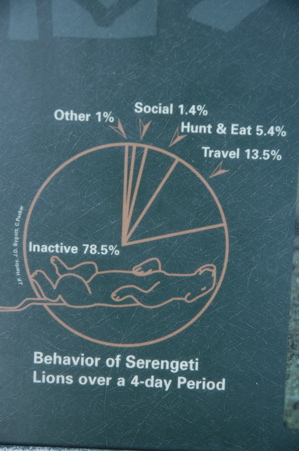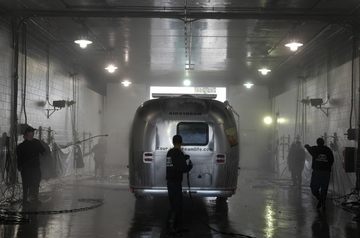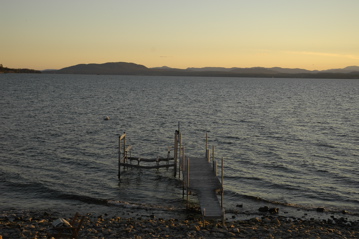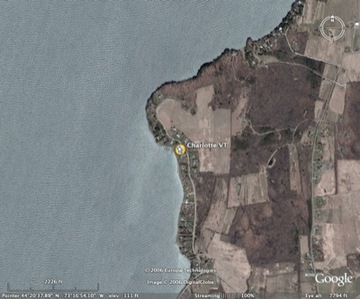Archive for FAQs
November 9, 2006 at 12:25 pm · Filed under FAQs
Once in a while, you’re going to get ants. It seems to happen to us once or twice a year. One day you’ll see a line of little brown “sugar” ants marching along and then they’ll be appearing everywhere in the trailer.
We picked up a batch of them in Haines City. I saw the ant hills in the driveway, and within hours they were climbing our water hose and ransacking the trailer for snacks. Fortunately, these little brown ants don’t sting like Fire Ants.
The best way to deal with ants is not to get them in the first place, but that’s pretty tough to do. We could have taken precautions by spraying around the trailer with something that would discourage them, but not on the fresh water line. We use a woven roll-up water hose and I would expect pesticides to leach through and contaminate our water, so that’s out. Bill Reilly suggested soapy water, but by the time we spotted the ants climbing the hose it was already too late.
Getting them is not the end of the world. We buy little ant traps, which probably do nothing but they make us feel better while we wait for the ants to go away on their own. Baiting outside the trailer isn’t usually helpful since we move regularly. A change of season or location seems to help more.

These jars are available at many home goods & kitchen ware stores
We also are sure to keep all attractive edibles in tightly sealed containers. This means foods that are opened and then stored outside the refrigerator, like cereals and cookies, get transferred from their original boxes to zip-locked bags or airtight containers. During ant season, we clean around the stove, counters, and floors extra carefully. This morning we pulled out all the previously-opened containers in the pantry to wipe them down, to eliminate crumbs and drips.
One thing we won’t do is spray anything toxic inside the trailer. It’s too confined a space. The ants we’ve gotten seem to be either self-limited (having a short season) or discouraged by our frequent movement, so drastic measures haven’t been necessary. They’re always gone in a week or two. But now we are in Florida and not moving as much, so we may put an outdoor perimeter spray in place later this week, just to ensure we don’t pick up more of the little buggers.
By the way, you may notice we’ve added a little thing called a “captcha” on our Comments form. It’s one of those little codes you have to type in before your comment will go through. I apologize for having to do this. The blog has been getting relentlessly spammed lately by robots, and this should help reduce the problem.
This Sign of the Week depicts the daily behavior of a lion, but I suppose you could replace lion with an average RV’er and the breakdown of time would be about the same!

October 31, 2006 at 9:26 am · Filed under FAQs
After work on Monday, we walked over to the beach at sunset and helped Emma build a little sand castle while the clouds turned pink and deep blue. The temperature was about 70 degrees, there was a warm breeze off the water, and hardly a soul out there except us.
So we decided to stay one more night. This place is just too beautiful right now. I want to get out there tonight and see if I can capture some of it with my camera. And Emma wants a beach day today.
Here’s a panoramic shot of the St Augustine harbor from Sunday, showing (from left to right): the Santa Maria restaurant; cranes dismantling the old Bridge of Lions; the temporary bridge in the background with steel-framed drawbridge; sections of the old bridge still to be removed, to the right; and a sailboat motoring majestically in to pass under the drawvbridge and head out to the Atlantic.

Click for much larger image!
A few days ago I talked about my classification system for vintage trailer projects. Today I want to follow up with some thoughts on buying “restored” trailers. Here’s how I classify them:
“Polished Turd” restoration: These are really common on eBay. Typically the body has been polished, and some easy items like propane tanks may have been upgraded. The hallmark of these trailers is that many cosmetic repairs have been done, such as replacement floor covering (black-and-white vinyl peel-and-stick tiles are popular with eBay sellers).
Coca-Cola memorabilia, new curtains, upholstery, and countertops are common upgrades in these trailers — it makes them look good for the photos. But typically floor rot has not been appropriately fixed (many don’t know the right method, which is as bad as not fixing it at all!), household appliances have been substituted (especially electric refrigerators), non-period accessories and hardware are used, etc. Running gear is sometimes serviced, but not always. Serious structural problems may remain.
Polished turds go for big bucks on eBay, usually sold to people who don’t know what holds an Airstream together, or are who are buying their first vintage trailer. I hate to see this happen and I often get emails or calls from the regretful buyers, asking for help. Of course by then, it’s too late. eBay really means it when they say Caveat emptor.
“Amateur” restoration: Many people do their own restorations and learn as they go. This doesn’t make them bad but it does make it essential to review the work carefully. Many parts are typically replaced, including appliances, countertops, axles, upholstery, glass, subfloor, floor covering, windows, locks, propane bottles and regulator, brakes, etc. These restorations range from great bargains because the seller essentially is giving away his time and has done a good job — to great disasters, because the seller has done lousy work throughout and fixing everything the right way would cost more than just starting fresh with a new project.
If you are considering an amateur-restored trailer, get a second opinion from someone who knows vintage trailers, before you buy! Photos are not enough.
“Pro” restoration: A reputable professional shop has thoroughly refurbished the trailer. Typically such a restoration starts around $30k and goes up rapidly from there. If you are considering one of these, talk to the shop that did the work and find out what was done.
Reputable Airstream shops are not known by their pretty websites, but rather by their reputation in the community. Everyone knows the name of the owner(s) because the owner is proud of their reputation and is a public figure in the vintage trailer community. Examples include Craig Dorsey, Colin Hyde, Eric Drugge, Dave & Martha Makel, Ron & Linda Amme, and others. If they do good work, you’ll have no trouble finding plenty of people who have used the shop and recommend it. If the shop can’t point to a dozen satisfied past customers who you can readily interview, you have reason to be suspicious.
I’ve received plenty of emails about certain hacks out there who claim to be good trailer restorers but have a terrible reputation. All I can say is, ask around before you hire a restorer, or buy a trailer that was “professionally” restored.
“Show quality”: Once in a while a restoration goes over-the-top and comes out absolutely spectacular. No detail is overlooked. All components are original or much better than new. The trailer has not even a blemish. Special upgrades are often hidden in the original design, such as wi-fi, satellite TV, hidden A/C, extra refrigerators, etc. Such trailers typically cost in the six figures if professionally restored, and they don’t come up for sale often.
I’m putting all this forth in the hope that fewer people will get ripped off buying lousy trailers. If you’ve got a friend who is considering buying something without a proper inspection, tell ’em to read this blog entry before they blow their cash on what could be a nightmare.
October 27, 2006 at 8:36 am · Filed under FAQs
As we were leaving Virginia Beach I was tempted once again by a local “RV/Truck Wash” place, and once again I regretted even trying it.
Towing in urban areas and down Interstate highways eventually results in a brownish oily film on the Airstream which will not rinse off in the rain. When it gets to the point that we don’t even want to touch the trailer, it’s time for a wash.
But not just any wash. There are only two good ways I’ve found to get an Airstream clean: (1) Hand wash with sponges (we use a microfiber towel to wipe it down after the sponge); (2) Take it to a Blue Beacon truck wash.
The local do-it-yourself washes have never worked for us, and we’ve tried many of them. If you use the brushes they supply, you will put small scratches in the clearcoat that look horrible in the sunshine. (Don’t ask me how I know that, it’s too painful. But I can tell you that wax minimizes the damage.) If you don’t use the brushes, the trailer comes out approximately as dirty as it went in no matter how many times you hit it with the high-pressure soap wand.
The other thing that annoys me about the do-it-yourself washes is that they never seem to have the proper clearance in the parking area for a big trailer like ours. So the end result of about 30 minutes and $15 in quarters at the RV/Truck wash yesterday was a dirty trailer and a few gray hairs from trying to shoehorn the trailer into the “truck” bay and then get it out again. Very disappointing.
Never again. Blue Beacon is $36 for the truck and trailer, but it’s the only wash we’ll use in the future, unless we do it ourselves. They are easy to access, they use only the wands when I ask them (not brushes), the staff have always been immensely polite, and they tolerate me standing around taking pictures and asking dumb questions. I guess they use a better grease-cutting soap than the local car washes because the trailer always comes out beautifully shiny.

We keep a little fold-up paper directory of Blue Beacon locations in our truck, and visit them about every 3-4 months. No, they didn’t pay me to give this endorsement, I just really like their service and the job they do. (But hey, if Blue Beacon management is watching, I sure wouldn’t mind a few coupons or something …)
Yesterday we managed to avoid the dozens of exhortations by “Pedro” to visit South of the Border, and scuttled right down to Florence, SC, where we are overnighting at the Cracker Barrel. The Blue Beacon was about the pinnacle of excitement all day, but we did manage to meet some other Airstreamers in the parking lot of the Food Lion grocery in Emporia VA in the morning. They’d come over from Washington state a month ago in their 2005 Airstream International CCD Bambi 19. We gave each other quick tours of our trailers before heading down I-95. It’s always fun to randomly meet people with whom we have things in common.
October 26, 2006 at 9:40 am · Filed under FAQs
Since I wrote that I was buying the 1953 Flying Cloud, I’ve received a number of comments from friends about the wisdom of my choice. A few samples:
Tim Shephard of The Vintage Airstream Podcast: Well, you have blown all hope that you were my *level headed* AS buddy.
J. Rick Cipot, contributor to Airstream Life: That is awsome! What a fantastic find. Do you get to keep all the clutter too? It looks like everything is there. This is museum quality stuff. I hate you!
Dicky Riegel, group VP of Thor: Cool trailer, and I always love seeing the California trailers with the vertical front and rear. So different from my trailer, yet still the same lineage.
Fred Coldwell, vintage Airstream historian: …check closely around both wheel wells even if you have to move a bunch of junk to see back there …. and check the frame outriggers at each end of each wheel well for rust and some disintegration. Good luck!
You get the idea. Everyone has a different perspective on it, but in the end we are all Airstream nuts.
Evaluating this trailer’s condition made me think about the classes of vintage trailer projects that we commonly see. Normally, people either look at trailers as “poor, fair, good, very good, excellent,” or they just look at the polish and figure it must be good if it’s shiny. I have come up with the following classification system to better rate vintage projects:
Parts trailer: Less than 30% of the trailer remains in restorable condition. A few random parts are usable. Body is heavily damaged. Appliances, furniture, running gear and accessories mostly damaged beyond economic repair or missing. OR, body severely damaged (as in an accident) and only interior parts remain.
Shell: Like the parts trailer, the parts are gone. But the body is very good. Use it as the basis for a custom trailer project (as in Project Vintage Lightning). Plan on expending serious money, since you’re building a new trailer with this type of project.
Refurbishment trailer: Body is lightly to moderately damaged, but 30-70% of the major components need replacement. Floor rot is present. This is the most common vintage project trailer I see, ideal for the “makeover” type of refurbishment, where the interior modified with modern parts and/or new floorplan.
Restoration trailer: Light damage is acceptable to all components, but less than 30% is destroyed, missing, heavily modified, or in need of replacement. There may be limited floor rot but leaks have not severely damaged the furniture. These trailers are fairly rare, especially in the 1950s and early 60s, since few have managed to last through the decades without major accidents or leaks. These are great candidates to be brought back to original condition.
Survivor: The rarest type of trailer. These need less than 20% of their parts refurbished. Few owner modifications have been done. Nearly all of the components are in good condition and need only light clean-up or maintenance. These are excellent candidates for museum pieces, but usually only can be found when the trailer has been stored out of the weather for many years, or in a dry climate.
—–
The 1953 Flying Cloud I bought falls somewhere in the upper end of the “restoration trailer” category. It’s about 90% original but one piece of furniture is missing and it has known floor rot. All of the appliances are there but all need clean-up and maintenance. The body has several owner modifications which need to be un-done, and there are several body panels which require replacement.
The classification system above refers only to trailers in “as found” condition. Trailers that have been “restored” by a modern owner need their own classification system, because there are a wide range of restorations going on. I’ll talk about those tomorrow.
Today we are heading out to I-95 for what may be a dull day of driving. But we’re in search of warmer weather, and no doubt some small adventures will come our way today!
September 27, 2006 at 11:12 am · Filed under FAQs
I know that a lot of people read this blog to capture ideas for their own travel in the future. That’s why I talk honestly about the good and the bad, our experiences with equipment, people, and places. It’s my hope that you can get an idea of what’s waiting for you when you get on the road yourself.
Lately I’ve been talking a lot about non-travel subjects like divesting household stuff and getting our tow vehicle serviced. That’s because it’s part of the lifestyle. It’s not glamorous dealing with some issues, but absolutely necessary. I find a lot of people have questions about seemingly mundane things like “How do I decide where to go first?” and “What do I do with my furniture?” I can relate because those little things can be the difference between going and being bogged down by uncertainty.
But there’s another, more selfish, reason that I blog. While I enjoy helping others get going, and sharing our adventures, I also benefit from your feedback. As of this month, over 5,000 people read our blog. So when I have a problem, I can call on you for help — and that’s incredibly powerful.
For example, yesterday I mentioned needing an address for our scammer, and having some things to give away. Right away, two blog readers offered their addresses, and another one made arrangements to get some of our stuff from storage. When we have had a problem, blog readers have been there to help us out. When we’ve needed a place to stay, you’ve offered us courtesy parking. This two-way interaction makes the whole thing work.

So the answer to the question of “Where should I go?” can be found if you take the time to share your experience with other people. We get invitations to camp, invitations to join rallies, and suggestions of really terrific places to go, all the time from our Internet friends like you. The Internet blog phenomenon isn’t just an egotistical expression of a few outgoing people. It’s a form of communication that really adds value to an adventure like this — changing what was a solitary pursuit (full-time RV’ing) into a group experience.
The new generation of RV’ers is different that way. A decade ago, the big full-time RV trip was almost solely for retirees, who effectively dropped out of communication for long periods of time. Now, we are a generally younger crowd (the average new Airstream buyers are still working and in their 50s). We are in constant communication through our cell phones and Internet. And it works for us, because going out on the road is no longer just about dropping out — but equally about dropping in, in other words, seeking out new experiences, new people, and sharing those things.
That’s why this blog continues. In about a week I (with occasional contributions from Eleanor and Emma) will have been blogging this experience for a full year. It has been a massive amount of work, but I foresee us continuing the blog for at least another four months, probably longer. I’m happy to do it because you make it worthwhile.
Eleanor is dropping off more stuff from storage with friends today: a box of cherry wood scraps, a cherry table (sold), kid’s stuff for the local playgroup, and leftover building supplies from our former house. I’ve made contact with a local guy who takes good household items and donates them to needy families, so he’ll meet us Saturday with his truck to take some furniture. I’m hoping by Sunday we’ll have our remaining stuff reduced to just one storage unit, which has been our goal all along.
August 24, 2006 at 2:02 pm · Filed under FAQs
I’m also experimenting with another possible feature of this blog. If you’ve heard of Google Earth but haven’t tried it, get a copy soon. It’s really spectacular. You will need broadband Internet and a recent-model computer to use it, however.
You can install Google Earth from this link. It’s now available for PC and Macintosh. Here’s Google’s own description of it:
Google Earth streams the world over wired and wireless networks enabling users to virtually go anywhere on the planet and see places in photographic detail. This is not like any map you have ever seen. This is a 3D model of the real world, based on real satellite images combined with maps, guides to restaurants, hotels, entertainment, businesses and more. You can zoom from space to street level instantly and then pan or jump from place to place, city to city, even country to country.
I have used Google Earth to create a “placemark” for the location where we have parked the Airstream. The placemark comes in the form of a “.KMZ” file, which you can download:
Download our current parking location here!
If you have Google Earth, opening this file should allow you to instantly “fly” right to a view of our parking spot! Very geeky … and fun!

Now, keep in mind this is just an experiment. I won’t be able to do this every day because I won’t always have broadband Internet (Google Earth won’t work without it). But, if you like it, I’ll try to post some of our more interesting camping locations.
Another thing to keep in mind is that the satellite imagery you’ll see on Google Earth is not real-time. So you won’t see our Airstream. In fact, the image for today’s parking spot appears to be at least 15-20 years old. The road has been paved since this image was taken. But, it’s good enough for a general idea of the setting.
Try it out and let me know how it works, OK? Thanks!
August 24, 2006 at 12:30 pm · Filed under FAQs
Good news! I finally hooked up some easy links on the website so you can subscribe to our weblog without having to remember to visit it every day.
Just hit this page and click one of the colorful little “chiclets” to the left, just below where it says “SUBSCRIBE”. You can use Yahoo, AOL, Newsgator, Bloglines, or Inclue — your choice.
If you have the Firefox browser, you can also click the little orange RSS symbol too, to subscribe using your browser instead of a third-party service. Click below, or click the identical orange symbol that appears in the address bar of your browser. Other browsers may support RSS as well.

« Previous entries ·
Next entries »






